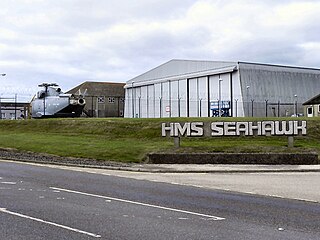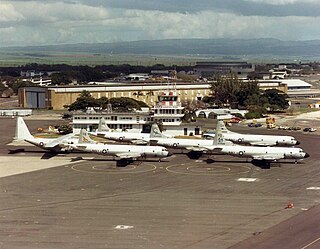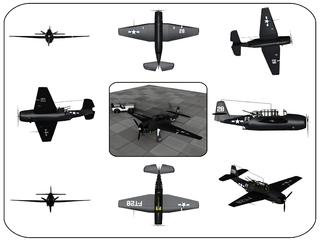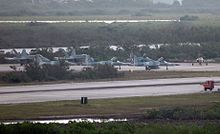
Moffett Federal Airfield, also known as Moffett Field, is a joint civil-military airport located in an unincorporated part of Santa Clara County, California, United States, between northern Mountain View and northern Sunnyvale. On November 10, 2014, NASA announced that it would be leasing 1,000 acres (400 ha) of the airfield property to Google for 60 years.
Most countries with military aviation forces have a system for naming of military airbases. "Air Force Base" ("AFB") is part of the name of military airbases of the United States Air Force (USAF) and the South African Air Force (SAAF), with the USAF using it at the end of the name of the base, and the SAAF using it at the start. The Royal Australian Air Force uses a slightly different format referring to bases as "RAAF Base". The Canadian Forces also uses a different format referring to any base as "CFB" or "BFC" in French.

Naval Air Station Glenview or NAS Glenview was an operational U.S. Naval Air Station from 1923 to 1995. Located in Glenview, Illinois, a suburb of Chicago, the air base primarily operated training aircraft as well as seaplanes on nearby Lake Michigan during World War II. Reconfigured as a Naval Air Reserve base following World War II, NAS Glenview supported Naval Air Reserve, Marine Air Reserve/4th Marine Aircraft Wing, and U.S. Army Reserve 244th Aviation Group as well as an active duty Coast Guard Air Station.

Royal Naval Air Station Yeovilton, commonly referred to as RNAS Yeovilton, is a military airbase of the Royal Navy, sited a few miles north of Yeovil, in the English county of Somerset. It is one of two active Fleet Air Arm bases, the other being RNAS Culdrose. RNAS Yeovilton is currently home to the Royal Navy Wildcat HMA2, along with Army Air Corps Wildcat AH1 helicopters, as well as the Royal Navy's Commando Helicopter Force Merlin HCi3/4/4A and Wildcat AH1 helicopters.

Naval Air Station Jacksonville is a large naval air station located approximately eight miles (13 km) south of the central business district of Jacksonville, Florida, United States.

Naval Air Station Corpus Christi is a United States Navy naval air base located six miles (10 km) southeast of the central business district (CBD) of Corpus Christi, in Nueces County, Texas.

Naval Air Station North Island or NAS North Island, at the north end of the Coronado peninsula on San Diego Bay in San Diego, California, is part of the largest aerospace-industrial complex in the United States Navy – Naval Base Coronado (NBC), and the home port of several aircraft carriers of the United States Navy.

Naval Air Station (NAS) Oceana or NAS Oceana is a United States Navy Naval Air Station located in Virginia Beach, Virginia.

Naval Air Station Whiting Field is a United States Navy base located near Milton, Florida, with some outlying fields near Navarre, Florida, in south and central Santa Rosa County, and is one of the Navy's two primary pilot training bases. NAS Whiting Field provides training for U.S. Navy, U.S. Marine Corps, Coast Guard, and Air Force student pilots, as well as those of several allied nations. NAS Whiting Field is home to Training Air Wing Five.

Royal Naval Air Station Culdrose is a Royal Navy airbase near Helston on the Lizard Peninsula of Cornwall UK, and is one of the largest helicopter bases in Europe. Its main role is serving the Fleet Air Arm's front line AgustaWestland Merlin helicopter squadrons.

Naval Air Station Cecil Field or NAS Cecil Field was a United States Navy air base, located in Duval County, Florida. Prior to October 1999, NAS Cecil Field was the largest military base in terms of acreage in the Jacksonville, Florida area.

Naval Outlying Landing Field (NOLF) Imperial Beach is a United States Navy facility for helicopters, situated on 1,204 acres (5 km2) approximately 14 miles (23 km) south of San Diego and within the city limits of Imperial Beach, California. It is known as "The Helicopter Capital of the World".

Naval Air Station Barbers Point, on O'ahu, home to John Rodgers Field, is a former United States Navy airfield closed in 1999, and renamed Kalaeloa Airport. Parts of the former air station serve as a film and television studio for the Hawaii State Film Office.

Naval Air Station Fort Lauderdale was an airfield of the United States Navy just outside Fort Lauderdale, Florida.

Naval Support Activity Mid-South, in Millington, Tennessee, is a base of the United States Navy. A part of the Navy Region Southeast and the Navy Installations Command, NSA Mid-South serves as the Navy’s Human Resources Center of Excellence. The base is host to several commands and other military tenants: Navy Personnel Command, Navy Recruiting Command, the Navy Manpower Analysis Center, a Marine Corps Reserve Company - Bridge Company C and the US Army Corps of Engineers Finance Center. More than 7,500 military, civilian, and contract personnel are assigned/work on base.

Coast Guard Air Station Miami is an Air Station of the United States Coast Guard located at Opa-locka Executive Airport in Opa-locka, Florida. The station operates the HC-144 Ocean Sentry maritime patrol aircraft and the MH-65 Dolphin helicopter.

California during World War II was a major contributor to the World War II effort. California's long Pacific Ocean coastline provided the support needed for the Pacific War. California also supported the war in Europe. After the Japanese attack on Pearl Harbor on December 7, 1941, most of California's manufacturing was shifted to the war effort. California became a major ship builder and aircraft manufacturer. Existing military installations were enlarged and many new ones were built. California trained many of the troops before their oversea deployment. Over 800,000 Californians served in the United States Armed Forces. California agriculture, ranches and farms were used to feed the troops around the world. California's long coastline also put the state in fear, as an attack on California seemed likely. California was used for the temporary and permanent internment camps for Japanese Americans. The population grew significantly, largely due to servicemen who were stationed at the new military bases/training facilities and the mass influx of workers from around the U.S. in the growing defense industries. With all the new economy activity, California was lifted out of the Great Depression. Over 500,000 people moved to California from other states to work in the growing economy. California expanded its oil and mineral production to keep up with the war demand.

Naval Base Hawaii was a number of United States Navy bases in the Territory of Hawaii during World War II. At the start of the war, much of the Hawaiian Islands was converted from tourism to a United States Armed Forces base. With the loss of US Naval Base Philippines in Philippines campaign of 1941 and 1942, Hawaii became the US Navy's main base for the early part of the island-hopping Pacific War against Empire of Japan. Naval Station Pearl Harbor was founded in 1899 with the annexation of Hawaii.



















